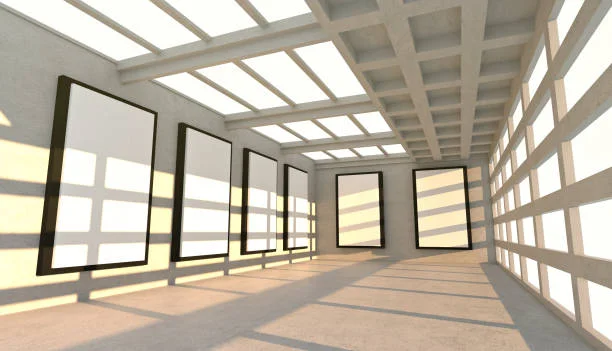When considering how to design or adapt a room for displaying art, one question often arises: can an art exhibition room have windows? While this may seem like a simple architectural decision, it opens up a deeper conversation about how light, space, and the act of viewing interact in artistic environments. Windows, though common in most buildings, serve complex and sometimes contradictory roles in exhibition settings. Whether a gallery should embrace or eliminate windows depends on multiple factors, including the nature of the artworks, the intended ambiance, and the dialogue between interior and exterior worlds.
The Dual Nature of Windows in Exhibition Spaces
At first glance, windows might appear as potential distractions in an art gallery. They take up valuable wall space that could otherwise be used to hang artworks, and they naturally draw the eye toward the outside world. From this perspective, having windows in an exhibition room can feel like trying to draw over an already half-completed image—competing with, rather than supporting, the displayed works.
However, to dismiss windows outright overlooks their ability to enrich an exhibition. In fact, the presence of windows can serve as a deliberate curatorial choice. Choosing to retain windows in a gallery space signals an openness to the surrounding environment—embracing local architecture, natural light, and even the historical context that frames the building. In this way, windows can become an extension of the narrative told by the artworks within.
Light as a Curatorial Tool
Natural light, when carefully controlled, can significantly enhance the viewer’s experience. Windows act as gentle conduits, allowing sunlight to filter into a space without overwhelming it. This subtle interplay of light and shadow can help animate an exhibition room, giving it a sense of vitality and movement.
Architectural examples, such as the central hall of the National Museum of Modern and Contemporary Art (MMCA) in Gwacheon, showcase how even limited natural light—channeled through skylights and narrow windows—can evoke an atmosphere of reverence. The space feels almost celestial, not due to excessive brightness, but because of the way light is used to define form and evoke emotion.
Conversely, in the Seoul MMCA, designers adopted a more grounded approach. Here, light is diffused evenly throughout the space, minimizing shadows and removing symbolic implications. The result is a flexible, neutral platform—an open invitation for a wide variety of art practices to coexist without competition. In such settings, the absence of prominent windows helps to regulate how visitors experience both the space and the art within it.
Explore related articles to deepen your understanding before you go.
Windows as Conceptual Elements
While practical considerations often guide decisions about lighting and layout, windows can also serve a more conceptual role in exhibitions. Artist Minae Kim, for instance, uses artificial light, mirrors, and simulated windows to question the boundaries of visibility and perception. These mock windows don’t just illuminate a room—they challenge our understanding of what light is and where it comes from.
In one striking example, Kim’s installations at MMCA Seoul use reflective surfaces to mimic windows, prompting viewers to confront the illusion of light and the physical structure of the museum itself. Her work reveals that a window doesn’t have to be real to create the effect of openness or insight. It’s a metaphor as much as an architectural feature—an emblem of longing for another place or a different reality.
The Psychological Pull of the Window
The fascination with windows is not limited to contemporary design. As explored in the Metropolitan Museum of Art’s exhibition “Rooms with a View: The Open Windows in the 19th Century,” artists have long used windows as motifs of introspection and transition. These images—solitary figures gazing outward or rooms bathed in filtered light—reflect a universal human desire to connect with something beyond the immediate present.
This emotional and psychological aspect of windows adds another layer to the question: can an art exhibition room have windows? Perhaps it’s not just about light or space but about our innate need to reach beyond the walls we inhabit.
Reclaiming Public Spaces with Art and Windows
Beyond traditional museums and galleries, projects like Art Rise Savannah’s “Vacant Windows” demonstrate how windows can be repurposed to bring art into everyday life. By turning unused storefront windows into mini galleries, artists like Sheng Wang transform public walkways into spaces of artistic engagement. These installations dissolve the boundaries between private and public spaces, interior and exterior, encouraging passersby to engage with art in an unexpected, spontaneous way.
As founder Clinton Edminster puts it, “The magic is the windows.” These displays don’t just offer visibility; they create a relationship between the viewer and the space—one rooted in curiosity, accessibility, and community.
The Final Frame: Are Windows Right for Your Exhibition?
So, can an art exhibition room have windows? Definitely—but whether it’s the right choice depends on your specific goals and purpose. Windows can enrich an exhibition by offering natural light, architectural depth, and emotional resonance. They can connect visitors with the outside world or act as a metaphorical portal to new ways of seeing. Yet, they also introduce challenges in lighting control, wall space, and curatorial focus.
Ultimately, the decision to include windows in an exhibition room isn’t about aesthetics alone. It’s about purpose—whether that’s to create a contemplative sanctuary, a neutral display platform, or a vivid conversation between art and life. Like art itself, the role of windows in exhibition spaces is multifaceted, ever-evolving, and deeply human.
There’s plenty more where that came from—browse our other helpful content!







